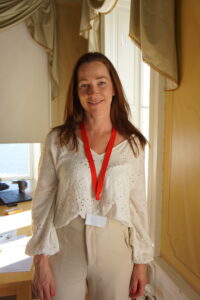Parents crucial when children with deafblindness develop language
Kuurosokeus
8 touko 2023
"Every time I went to a course aimed at professionals working with deafblindness I thought 'But this is what parents need to learn!'", says Janna Brattli, mother of three-year old Jenny who has congenital deafblindness. Now Janna wants to raise the parental perspective on developing language with a child with deafblindness.
At the end of April 32 people gathered in Stockholm for a three-day course; Co-creating language with children with deafblindness. 31 of them were professionals working with persons with deafblindness in one way or another, and the 32nd was Janna Brattli, mother of Jenny, a three-year old girl who has a severe hearing loss and is completely blind.
– If you as a parent don’t know how to develop spoken language, then you can’t help your child with other kinds of language, such as tactile sign language or ways of expression that are not signs but saying something with body and movement, says Janna Brattli.
Exploring a glass of water
Janna contributed to the course by giving a lecture about the parental perspective adding lots of examples from her daily life with Jenny.
– At one point, for at least six months, it became impossible to bathe Jenny. We don’t know why but it was like torture for her. We had to start with a glass of water for her to explore with her hand to gradually make her enjoy bathing again, explains Janna Brattli.
Parents are an important resource
 All children are born with an intention and a desire to communicate, regardless of language and form of communication, but children with congenital deafblindness express themselves in different ways. It can be through speech, sounds, signs, bodily signals, or other expressions.
All children are born with an intention and a desire to communicate, regardless of language and form of communication, but children with congenital deafblindness express themselves in different ways. It can be through speech, sounds, signs, bodily signals, or other expressions.
– These children need people around them who can understand and meet their expressions, as language. It can be difficult for the environment to recognize these expressions as language, and this requires a special competence also for the parents, says Marit Irene Vie, Senior adviser and family counsellor at Eikholt, Norway.
Marit Irene Vie also participated in the course in language development with a lecture. She sees parents as the child’s most important resource for promoting a good basis for language development.
– Parents know their child best, and parents who have a child with deafblindness can best tell what kind of support they need, says Marit Irene Vie.
Transfer knowledge to networks
Parents need information and knowledge from people who know more about expressing themselves in atypical ways, in order to practice interpretation, to understand and respond to this different form of communication. They also need knowledge of what is needed to facilitate language development.
– It is important that the parents gain knowledge about communication that is based on bodily expressions that the child creates based on his/her own experiences. It is also necessary to transfer knowledge to networks, such as the rest of the family, kindergarten and school, so that they also learn about a bodily-tactile way of communicating, says Marit Irene Vie.
The basic understanding is about recognizing, confirming, and using the same expressions as the child, but also expanding and supporting the child with tactile- or visual signs or words.
Curiosity helps to get knowledge
Janna Brattli sees a lack of courses that are directed at parents, instead she has attended four different courses or other kinds of gatherings mainly directed at professionals within the field.
– I have been to events for people working with deafblindness or combined sensory loss, events aimed at professionals – not parents. Every time I thought ‘But this is what parents need to learn!’, explains Janna Brattli.
It is her curiosity that has pushed her to explore this field.
– As a person, I’m curious and I often find out a little bit of everything, even if I don’t need the knowledge. For example, I do not need knowledge of how to cook in Istanbul, but it is interesting. When my husband and I had our daughter, it was an advantage to have that kind of curiosity. We listened to professionals and took in what they said, but also read on our own about how a person with combined sensory loss or deafblindness, can learn languages, says Janna Brattli.
Learning from her daughter
Janna Brattli has not only learnt a lot about language since her daughter was born, she has also learnt to appreciate new things.
– I have learned so much from my daughter Jenny! She has a closeness and a presence in touching a thing that can be best compared with if you have a loved one and you see a small birthmark on their neck, something completely unique to that person. Jenny has such a presence towards the little things in almost everything around her, says Janna Brattli.

